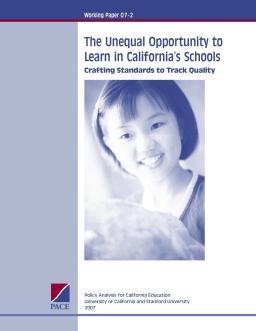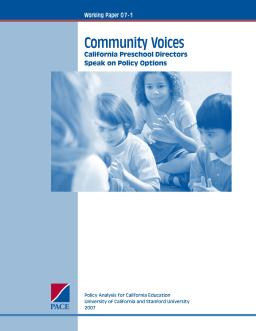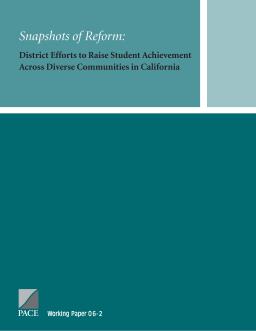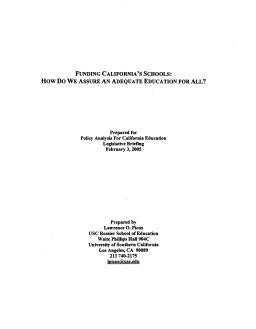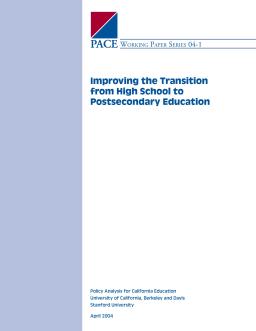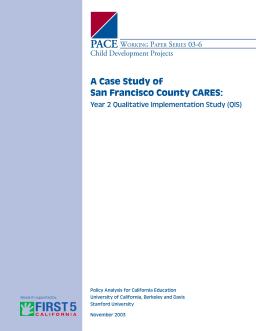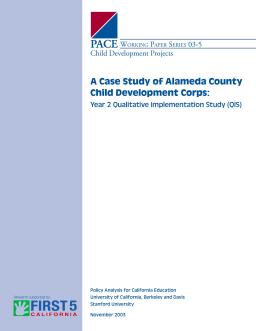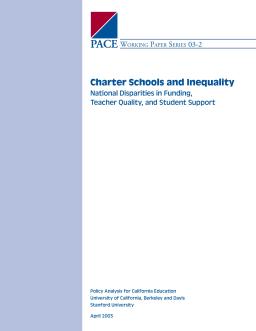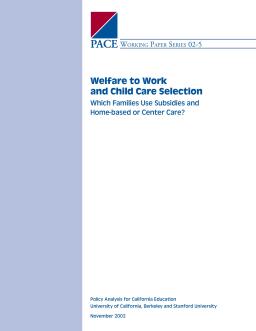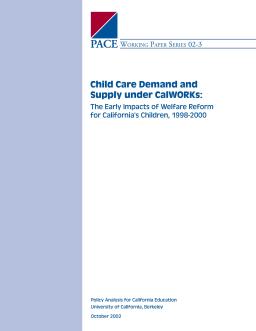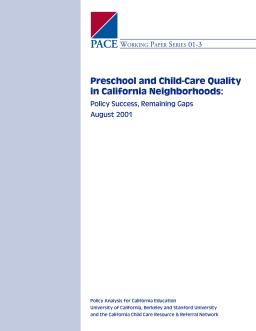The Quality Teacher and Education Act in San Francisco
Published
Summary
This policy report reviews the approval of Proposition A, a parcel tax initiative in the San Francisco Unified School District, which aimed to improve teacher salaries and fund innovative compensation programs. The report includes an assessment of the programs funded by the tax revenues, and is based on interviews and public documents.
Investing in Education Facilities and Stronger Communities
Published
Summary
California is midway through one of the grandest public infrastructure projects ever attempted. Over the coming decade school officials will complete an $82 billion effort, building new schools and renovating old facilities, supported by taxpayers and private investors. But are state officials and local planners building schools mindfully to advance educational quality and lift local communities?
Preschool and K–12 Finance Reform in New Jersey and Texas
Published
Summary
This report examines factors that affect student achievement in California schools, finding that family background and school context are important determinants. The report recommends that schools focus on providing high-quality instruction, improving reading and math skills, and creating a positive school climate. Policymakers should increase resources for under-resourced schools and promote parental involvement. Continued research is needed to better understand the complex factors that shape student outcomes.
Crafting Standards to Track Quality
Published
Summary
This paper investigates the effects of class size reduction (CSR) on student achievement in California's K-3 classrooms. Using data from the state's Standardized Testing and Reporting program, the authors find that smaller class sizes improve student achievement in English-language arts and have a stronger effect on low-income and minority students. However, the authors caution that the full benefits of CSR may be realized only with sustained implementation, quality teaching, and alignment with curriculum and instructional strategies.
California Preschool Directors Speak on Policy Options
Published
Summary
This report discusses the potential of integrating academic and occupational content through Career-Technical Education (CTE)/multiple pathways to improve California's high schools. This approach can enhance student motivation and engagement in school, improve employment and earnings after graduation, and provide more opportunities for students. They suggest building on existing practices in career academies, restructured high schools, and community colleges, but note that additional funding, technical assistance, and professional development will be necessary to support this approach.
District Efforts to Raise Achievement across Diverse Communities in California
Published
Summary
This paper examines the effectiveness of California's class-size reduction policy in elementary schools, finding that it improved student achievement in reading and math, particularly for low-income and minority students. However, it also concludes that the policy was expensive and had other trade-offs, such as limiting teacher collaboration and reducing funding for other important educational programs. The report suggests that policymakers consider more cost-effective and comprehensive approaches to improving student outcomes.
The Reliability of How States Track Achievement
Published
Summary
This paper analyzes the impact of the No Child Left Behind Act on the state's funding system and notes that it exacerbated inequities by penalizing schools that did not meet annual progress targets without providing sufficient resources to help them improve. The authors suggest that a more equitable funding system based on student needs and costs would better serve all students, including those who are struggling to meet academic standards.
The Influence of Preschool Centers on Children’s Social and Cognitive Development
Published
Summary
Using national data from the Early Childhood Longitudinal Study (ECLS-K), this study examines the association between center-based care duration and intensity and pre-reading, math skills, and social behavior of young children. Children who start center care between ages two and three see greater academic gains, while starting earlier than age two may have negative social effects. Center intensity impacts academic gains for poor and middle-income children, but not wealthier children, and negatively impacts social development for Blacks and whites but not Hispanic children.
Ideals, Evidence, and Policy Options
Published
Summary
Many California children benefit from preschooling, but enrollment rates are lower for poor and working-class families. Quality is uneven, and policy makers must address key questions regarding expanding and improving preschooling, including who should benefit and who should pay, who should operate it, how to improve quality, and how to structure it for diverse families. Evidence can inform policy options, which stem from differing ideals about preschooling. Nationwide evidence is considered in this review.
How Do We Assure an Adequate Education for All?
Published
Summary
California ranks 44th in the nation in education spending, spending only 86.1% of the national average per pupil in 2001-02. The recession of the early 2000s resulted in dramatic budget deficits for the state and substantial reductions to the expected level of school funding. Research suggests using the concept of adequacy to estimate the costs of providing an educational program that will enable all—or almost all—children to meet the state's high proficiency standards and offers recommendations for finding additional resources needed to adequately fund California's schools.
Who Gains, Who Loses?
Published
Summary
Over the past 30 years, a combination of court rulings, legislative enactments, and voter initiatives has made dramatic changes in the landscape of education governance in California. The presumption of local control, a system based on local electoral accountability, has been superseded by a system of centralized, administrative accountability. Among the most sweeping changes are those that affect the way in which the state’s public schools are financed. Until 1980, paying for elementary and secondary education was largely a local matter. Local property taxes paid most of the bills. The state...
Published
Summary
The Bridge Project, a study of K-16 issues, presents three papers on college transition. The first finds a widespread lack of knowledge about college requirements and readiness among California students and parents. The second analyzes how students receive vague signals about academic college readiness. The third provides an example of how to improve K-16 transition and send clearer academic standards signals. Policy implications include low or no-cost recommendations to address these issues.
Year 2 Qualitative Implementation Study (QIS)
Published
Summary
This paper assesses the perspectives and experiences of stakeholders on San Francisco County’s CARES program, a childcare retention–incentive program. Year 2 saw over a threefold increase in the number of stipends awarded, but recipients felt the program couldn't address ECE staff retention/turnover alone. Solutions need to be implemented within a larger system of support, raising public awareness, expanding professional development opportunities, and exerting pressure on policymakers for sustained funding to augment ECE staff salaries.
Year 2 Qualitative Implementation Study (QIS)
Published
Summary
This paper discusses the second year of Alameda County’s Child Development Corps program as a childcare retention-incentive program. The program's goals were to encourage staff training, professional development, and establish a strong network of ECE professionals. Stipend recipients were pleased with the program but recognized that it could not function alone in addressing staff retention, and a larger system of support and advocacy was necessary.
Published
Summary
The No Child Left Behind Act of 2001 mandates all states to demonstrate “adequate yearly progress” towards state proficiency goals. This report explores how to measure sustained improvement in California public schools, and how demographic and school-level variables relate to student achievement. Annual Academic Performance Index scores alone do not indicate sustained improvement, so it is recommended to consider student progress over a longer time frame and all known variables that impact it.
National Disparities in Funding, Teacher Quality, and Student Support
Published
Summary
Charter schools were intended to close the achievement gap and create tight-knit communities that motivate students and teachers. The assumption is that charter schools can avoid the disparities that public schools face. Recent data from the National Center for Educational Statistics (NCES) allows for comparison between charter and public schools. The survey data illuminates similarities and differences between the two types of schools.
Which Families to Serve First? Who Will Respond?
Published
Summary
This paper discusses extending access to preschool for families in California, focusing on targeting priorities to yield strong enrollment demand and discernible effects on young children's early development and school readiness. It analyzes different targeting mechanisms and suggests experimenting with alternative expansion strategies, rather than investing exclusively in one method. The report also describes which communities would benefit most and considers the criteria for judging the wisdom of targeting options.
Assessing Balance and Substance
Published
Summary
Arnold Schwarzenegger received lopsided media attention during the first weeks of his campaign, according to a UC study. 87% of the 164 stories reported by the New York Times focused on Schwarzenegger. Less coverage was given to Bustamante, who was out-polling the actor at the time. The study found little coverage of policy issues and that Schwarzenegger’s personal history and character received more attention. Lesser-known candidates, including Peter Camejo and Arianna Huffington, received proportionally less coverage.
Which Families Use Subsidies and Home-Based or Center Care?
Published
Summary
Public spending on childcare has increased, but low-income families still face barriers to accessing subsidies. This working paper examines the choices made by 1,974 parents in California who moved from welfare to work and needed childcare. The study found that parents relied on a mix of formal and informal childcare options, and that the expansion of one form of care did not necessarily influence parents' choices.
The Early Impacts of Welfare Reform for California's Children, 1998–2000
Published
Summary
This report examines the effects of welfare-to-work and childcare capacity building on the childcare system in California, prompted by changes in the childcare system and welfare reform. The study was requested by the California Department of Social Services, and this paper provides an overview of the findings.
Descriptive Findings from the Child Care Subsidy Interview
Published
Summary
CDSS and PACE conducted a survey of CalWORKs participants in Kern, Orange, and Santa Clara counties, interviewing 1,974 individuals in three languages. This report presents demographic data and survey responses, including frequencies and select responses by county, language, and ethnic groups.
Findings from the Child Care Providers Focus Groups
Published
Summary
This report presents findings from PACE's study on how California's childcare subsidy system and CalWORKs program impact licensed and license-exempt childcare providers. Five focus groups were conducted in 1999 and 2000, with topics organized by providers' services, philosophies of care, operational issues, and opinions about the subsidy system. The report provides insight into the experiences of childcare providers across California, but does not claim to be representative of the industry.
Published
Summary
This report discusses an initiative by the California Children and Families Commission to expand the availability and quality of early care and education programs. The project includes recruiting and training early care providers, improving professional preparation, and implementing strategies to retain trained providers. The report provides information on existing training programs available to early childhood professionals and students, including accredited/non-accredited opportunities at community colleges, state universities, private colleges, and child care resource and referral agencies.
Policy Success, Remaining Gaps
Published
Summary
This paper analyzes the quality of center-based programs in diverse lower-income communities in California. The majority of centers displayed high levels of quality, and community conditions such as poverty levels and ethnic composition did not consistently influence quality. Public subsidies positively affected center quality, while the presence of more programs in a community may slightly lower quality due to increased demand for enrollment.
Focusing on San Francisco and Santa Clara Counties
Published
Summary
This report analyzes California's early childhood education programs and finds that attending public preschool programs improves school readiness and academic performance, particularly for low-income children. The study also shows that the economic benefits of preschool programs far outweigh the costs, including increased earnings and decreased need for remedial education and social services. Recommendations include expanding access to high-quality preschool programs for low-income children in California to reduce economic inequality.



